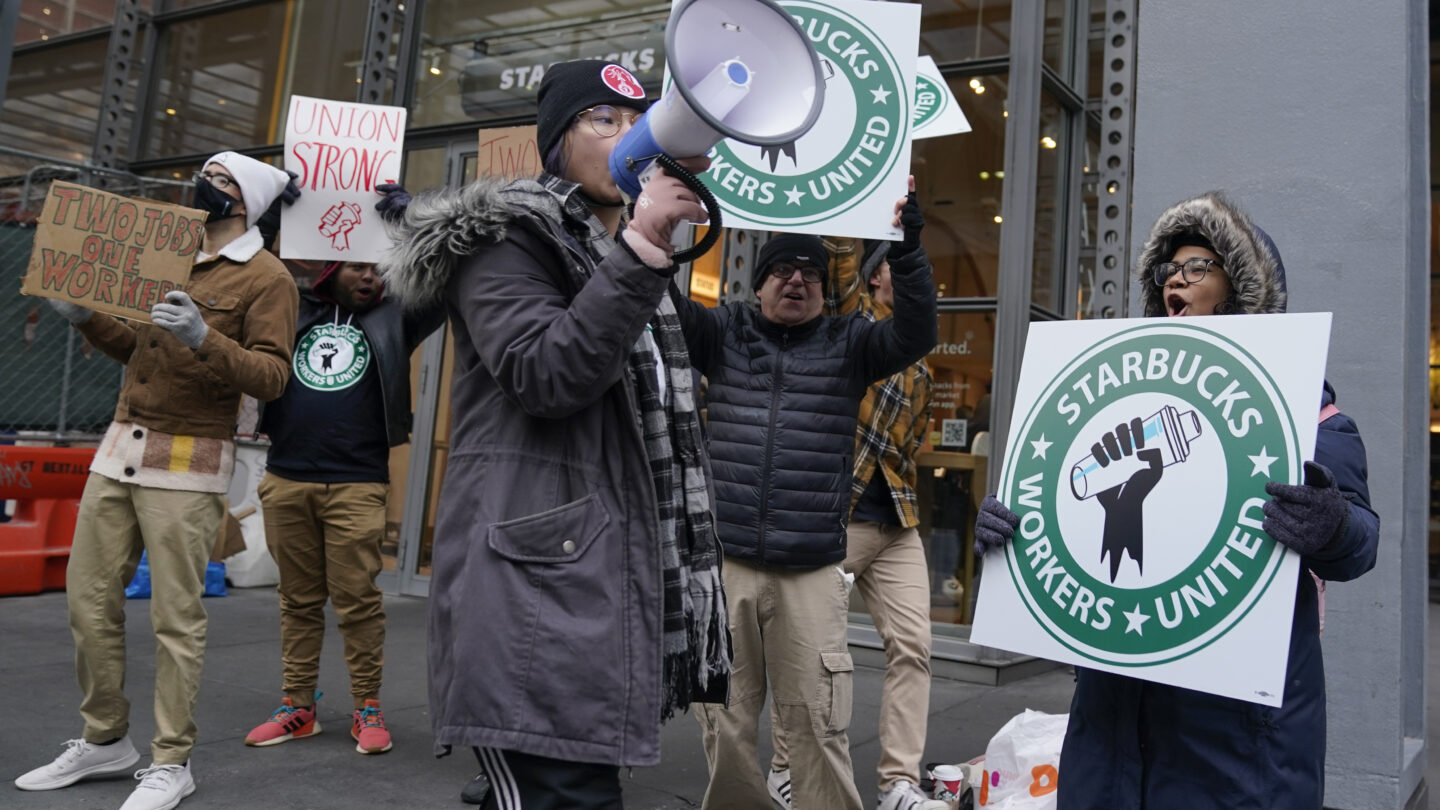You may have heard of the 'union boom.' The numbers tell a different story

Last year, labor unions in America looked like they were turning a corner. Employees at more than 250 Starbucks stores voted to unionize. Workers at Amazon warehouses, Trader Joe’s, and REI were joining the fight. Grad students. Uber and Lyft drivers. Even the knights, queens, and squires at Medieval Times were jousting to join a union.
Headline writers began declaring things like, “Employees everywhere are organizing” and that the United States was seeing a “union boom.” In September, the White House asserted “Organized labor appears to be having a moment.”
However, the Bureau of Labor Statistics recently released its union data for 2022. And their data shows that — far from a resurgence — the share of American workers in a union has continued to decline. Last year, the union membership rate fell by 0.2 percentage points to 10.1% — the lowest on record. This was the second year in a row that the union rate fell. Only one in ten American workers is now in a union, down from nearly one in three workers during the heyday of unions back in the 1950s.
To be sure, various data makes clear that the hubbub over a union resurgence last year wasn’t all hype. For one, the absolute number of American workers in unions did, in fact, grow in 2022 — by approximately 200,000. It’s just that the number of non-union jobs grew faster. The National Labor Relations Board saw 2,510 union representation petitions filed in fiscal year 2022 — a 53% increase over the previous year. That’s hardly a game-changer, but it’s something.
Last week, researchers at Cornell University’s School of Industrial and Labor Relations (ILR School) released the school’s annual report tracking labor actions across America. Alexander Colvin, the dean of the ILR school, says the data shows that something real was bubbling in the labor movement last year. They find that strikes, for example, were up 52% in 2022 over the previous year. However, considering we live in a nation with roughly 160 million workers, the absolute number of labor actions last year remains pretty small: 424 work stoppages (417 strikes and seven lockouts). Even the authors of the ILR School report note, “the level of strike activity is lower than earlier historical eras. The number of work stoppages and approximate number of workers involved in work stoppage is considerably less than the most recent comprehensive BLS data from the 1970s.”
In short, while there was an uptick in labor organizing in 2022, we’re hardly witnessing a rejuvenated movement strong enough to dramatically reverse unions’ long-run decline. That’s despite a historically tight labor market, worker dissatisfaction with their employers during the pandemic, a U.S. president who has proclaimed himself as “the most pro-union president leading the most pro-union administration in American history,” and the fact that unions are now more popular than they’ve been at any time since the 1960s.
Call it the union paradox: near-record-high popularity, but record-low participation.
What Explains The Union Paradox?
Suresh Naidu, an economist at Columbia University, has emerged in recent years as a leading scholar of unions in America. He and his coauthors have found influential evidence showing, for example, that unions played a critical role in boosting wages for American workers and reducing income inequality in the early-to-mid 20th century.
Last fall, when much of the press was enraptured by the idea of a union comeback, Naidu published an essay in The Journal of Economic Perspectives that offered a more clear-eyed assessment. All those headline-grabbing unionization stories at places like Starbucks and Amazon? “These are all drops in the bucket of the overall American labor market, and may or may not be harbingers of a resurgent unionism,” he wrote.
We wanted to get Naidu’s perspective on the union paradox. Why, despite their popularity, do unions continue to wither?
“American labor law just puts an enormous barrier in the way of workers joining a union,” Naidu says. “So you need to convince 50% plus one of your coworkers to join a union if you want a union.” That alone can entail a difficult and time-intensive campaign process. Meanwhile, he says, our labor laws make it relatively easy for employers to short-circuit organizing efforts. And even when some of their tactics are technically illegal, Naidu says, companies are given wide latitude to thwart unionizing with minimal legal sanctions. Union organizers are forced to strategize and organize outside their workplace and figure out how to convince coworkers to join the fight without getting penalized or fired. “Workers basically have to be like a little Navy SEAL team in order to successfully unionize under the radar of an employer,” Naidu says.
The obstacles to forming a union have only grown in recent decades. Around 27 states have passed “Right to Work” laws, which make forming a union more difficult in states with those laws and provide a refuge for companies looking to escape unions in states without those laws. Globalization, likewise, has given companies the option to close-up shop and move overseas. Automation has given companies the option to replace their workers with machines. Deregulation has increased industry competition and weakened unions’ ability to extract concessions from monopolistic companies. Various changes to labor law, by the U.S. Congress, by state legislatures, and by the federal courts, have made it harder for unions to grow and thrive. Corporations now spend millions and millions on highly paid consultants, developing effective tactics to suppress unionizing efforts and pressure their workers into submission. Even once workers form a union, it now takes an average of 465 days for the union to sign a contract with their employer.
Meanwhile, the economy continues to shift away from sectors that were traditionally union strongholds. As our economy grows and changes, the most unionized sectors in America — industries like manufacturing, transportation, and construction — represent an ever-shrinking share of the workforce. While this trend is more dramatic in the United States, Naidu says, it’s also seen in countries with stronger labor movements and labor laws more friendly to unions.
Of course, it doesn’t have to be this way. The service sector and other less-unionized sectors could theoretically jump on the union bandwagon. It’s why union boosters were so excited when the labor movement seemed to be finally awakening at places like Starbucks and Amazon.
But unionization in the service sector is apparently harder than in historic union strongholds like manufacturing. Academics continue to debate why that is. Naidu says he believes that in America, it has a lot to do with outdated labor laws, which put the impetus on workers at individual businesses to collectively organize their specific workplace. This proved effective when hundreds of employees worked side by side at large manufacturing plants, each working for the same employer for long segments of their careers. However, Naidu says, workplaces in today’s service sector tend to differ in at least two important ways.
First, turnover is much higher in the modern service sector than in the workplaces of the past, which may weaken worker solidarity and reduce the incentive to fight for a better working environment at a particular establishment (because workers don’t expect to work there long-term).
Second, Naidu says, workplaces in the service sector tend to be much smaller, which increases the logistical difficulty and transaction costs for unions to organize workplaces because they have to be organized painstakingly one by one, or Starbucks by Starbucks. “Even when these businesses are big, they tend to have many, many establishments such that each individual establishment is kind of small,” Naidu says. “And so it just makes it very, very hard to win a firm-wide union, which is the level at which American labor law protects.”
More Successful Organized Labor Models Overseas
Many other industrialized nations, like France, Iceland, Belgium, and Austria, for instance, conduct their collective bargaining differently and, Naidu says, they have higher rates of union membership to show for it. Instead of putting the onus on workers to organize individual businesses at the “establishment level,” these countries’ labor laws and customs empower unions to make collective bargaining agreements that cover whole sectors of the economy, whole classes of workers, or even their entire nation.
Collectively organizing entire sectors makes joining a union or benefiting from a collective bargaining agreement much easier for a larger swath of the workforce, and helps buoy the share of workers in unions. If a new business forms in a sector with an overarching labor agreement that covers all employers, the default is that new jobs are covered by it. That helps keep union membership rates high even when the economy is growing and changing. In America, when a new business forms, the default is non-union.
The flow of new, non-unionized jobs in America continues to overwhelm the share of already-unionized ones. For example, as mentioned above, the absolute number of union jobs increased by about 200,000 last year. However, the share of American workers in unions fell because non-union jobs grew faster. Naidu compares the system in the U.S. to a “hamster wheel.” “You have this natural business dynamism in the U.S., and unions need to be running to keep union density up,” he says. “Every time there’s a new employer, you’ve gotta be there trying to organize it. It’s just an incredibly slow and costly process to be engaged in.”
In his recent essay in The Journal of Economic Perspectives, Naidu argues that the labor laws of nations that encourage union agreements for entire industrial sectors, as opposed to the U.S.-style system of union agreements at individual establishments, creates an environment where unions are more able to flourish. In these countries, Naidu writes, “the hamster wheel of organizing every new shop is turned off, because new employers are automatically covered by the pre-existing agreement, and incumbent employers do not have to worry about cost competition from lower-wage employers in their sector.”
When a collective bargaining agreement applies to a whole sector, all the businesses in that sector are subject to it. This, Naidu says, weakens the incentives of companies to fight unions because their competitors are on a more even playing field vis-a-vis their workers.
Furthermore, Naidu says, the countries with the highest union rates not only have more expansive union agreements covering wide sectors of the economy, they also run various benefits, like unemployment insurance, through their unions. This creates a strong incentive for workers to join unions. “That stops the freeriding that you sometimes have where workers are like, ‘I don’t need to join the union because I get the benefits anyway,'” Naidu says.
The Importance of “Social Capital” For Labor Organizing
Because American labor law creates big barriers to forming a union, Naidu says, workers who want to form unions need a lot of what social scientists call “social capital” with their co-workers to overcome them. Social capital refers to tightnight social networks, characterized by solidarity, trust in one another, and a willingness to work together for collective goals. But, as has been well-documented by scholars like Harvard political scientist Robert Putnam, social capital in America has been plummeting since the mid-20th century. Putnam has found the decline reflected in, for instance, reduced participation in community organizations like churches and bowling leagues and surveys showing that Americans are more atomized and distrustful of each other than they were in the past.
“Union decline might be seen as yet another form of associational life that has declined for all the same reasons other forms have declined,” Naidu writes. “In this sense, the decline of unions may be as akin to the decline of churches as the decline of heavy manufacturing.” That worries him. “To the extent that you think American society could use a good dose of civil society and things like that, unions are one way to get that in the economy,” he says.
Unions and progressive politicians are currently fighting for the Protecting The Right To Organize (PRO) Act in the U.S. Congress, which would amount to a major reform of American labor laws. It, amongst other measures, would impose larger penalties on employers who try to squash unionization drives. While Naidu thinks this legislation will help, he believes even stronger reforms and a widespread grassroots movement is needed to finally reverse the decades-long decline of unions.
“Between the employer-side advantages given by US labor law and diminished workplace social capital, it is difficult to see a path to a persistent increase in union density that is not concomitant with a rewiring of workplace networks and a transformation of American labor law,” Naidu writes.
To really jumpstart unionization, Naidu believes, America needs big policy changes, including an embrace of sector-level bargaining, an increase in incentives for workers to join unions, and a reduction of incentives for companies to oppose unions. This might include awarding federal contracts only to companies that are pro-union, or imposing steeper penalties on companies that oppose unions.
Until then, Naidu suggests, the stream of stories about unionization drives at places like Starbucks and Amazon may just be that, anecdotes that amount to nothing more than a drop in the bucket. However, after years of witnessing a seemingly bottomless decline of unions, Naidu says, he is heartened that there are at least some signs of life. “I would have zero hope if it was not for the Starbucks and Amazon stories,” Naidu says. “But now I have some hope.”
9(MDAxODM0MDY4MDEyMTY4NDA3MzI3YjkzMw004))








